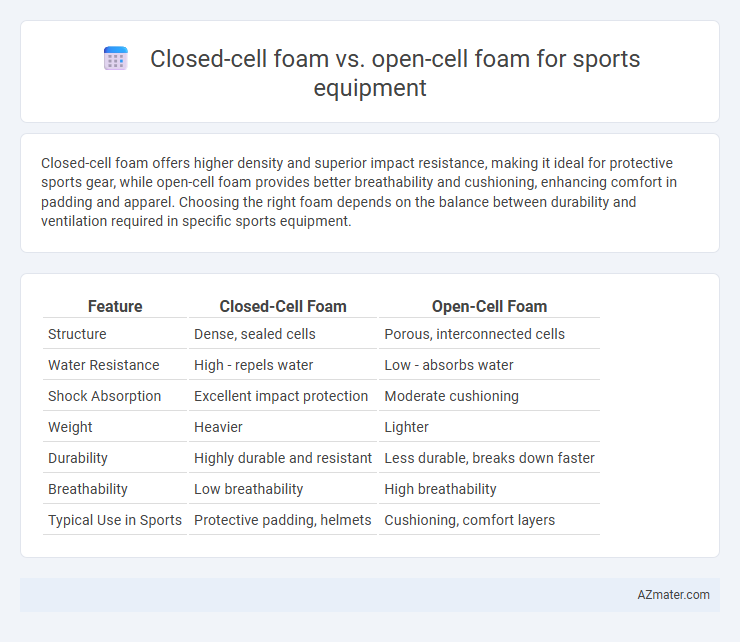Closed-cell foam offers higher density and superior impact resistance, making it ideal for protective sports gear, while open-cell foam provides better breathability and cushioning, enhancing comfort in padding and apparel. Choosing the right foam depends on the balance between durability and ventilation required in specific sports equipment.
Table of Comparison
| Feature | Closed-Cell Foam | Open-Cell Foam |
|---|---|---|
| Structure | Dense, sealed cells | Porous, interconnected cells |
| Water Resistance | High - repels water | Low - absorbs water |
| Shock Absorption | Excellent impact protection | Moderate cushioning |
| Weight | Heavier | Lighter |
| Durability | Highly durable and resistant | Less durable, breaks down faster |
| Breathability | Low breathability | High breathability |
| Typical Use in Sports | Protective padding, helmets | Cushioning, comfort layers |
Introduction to Foam Types in Sports Equipment
Closed-cell foam offers high density and excellent impact absorption, making it ideal for protective sports gear like helmets and padding. Open-cell foam provides greater flexibility and breathability, suited for comfort-enhancing applications such as insoles and cushioning in sports shoes. Understanding the distinct structural properties of closed-cell and open-cell foams helps optimize performance and protection in sports equipment design.
What is Closed-Cell Foam?
Closed-cell foam in sports equipment consists of tightly packed cells that trap gas, providing superior water resistance, durability, and shock absorption compared to open-cell foam. This dense structure enhances impact protection for helmets, padding, and insoles, making it ideal for high-performance athletic gear. Its low moisture absorption helps maintain consistent cushioning and hygiene during intense physical activities.
What is Open-Cell Foam?
Open-cell foam is a lightweight, porous material characterized by interconnected air pockets that provide excellent breathability and cushioning. It absorbs impact effectively, making it ideal for sports equipment requiring flexibility and shock absorption. Its open structure allows moisture to escape, enhancing comfort during physical activity compared to closed-cell foam.
Material Composition and Structure Comparison
Closed-cell foam consists of tightly packed, gas-filled cells that provide high density and excellent water resistance, making it ideal for impact absorption in sports equipment such as helmets and protective padding. Open-cell foam features interconnected cells that create a softer, more flexible material with superior breathability and shock absorption, commonly used in cushioning for apparel and footwear. The material composition and cellular structure influence durability, moisture management, and protective performance critical to athletic gear design.
Performance Differences in Sports Applications
Closed-cell foam offers superior impact absorption and water resistance, making it ideal for high-impact sports equipment such as helmets and protective padding. Open-cell foam, with its greater breathability and flexibility, enhances comfort and shock attenuation in applications like gloves and inner linings for endurance sports. The choice between closed-cell and open-cell foam directly affects durability, energy return, and athlete safety across varied sports disciplines.
Impact Absorption and Protection Levels
Closed-cell foam provides superior impact absorption and high protection levels due to its dense, rigid structure that efficiently disperses force during sports activities. Open-cell foam, while lighter and more breathable, offers less impact resistance, making it suitable for applications prioritizing comfort over maximum protection. For sports equipment requiring optimal shock absorption and durability, closed-cell foam remains the preferred material to minimize injury risk.
Durability and Longevity
Closed-cell foam offers superior durability and longevity for sports equipment due to its dense structure, which resists water absorption and maintains shape under heavy impact. Open-cell foam, while more breathable and flexible, tends to degrade faster and absorb moisture, reducing its lifespan in high-use environments. Athletes seeking long-lasting gear typically prefer closed-cell foam for enhanced protection and resilience.
Weight and Flexibility Considerations
Closed-cell foam in sports equipment offers superior weight savings due to its dense, rigid structure, providing enhanced protection without adding bulk. Open-cell foam is lighter and more flexible, allowing better conformability and comfort but may compromise impact absorption and durability. Choosing between these foams depends on the balance needed between lightweight performance and flexible cushioning for specific athletic applications.
Cost and Affordability Factors
Closed-cell foam is generally more expensive than open-cell foam due to its denser structure and superior durability, making it a higher-cost option for sports equipment padding and protective gear. Open-cell foam offers greater affordability and lightweight cushioning but may require more frequent replacement because of its lower resistance to moisture and compression. Budget-conscious buyers often prefer open-cell foam for cost-effective sports gear, while those seeking long-term investment choose closed-cell foam despite its higher initial price.
Choosing the Right Foam for Your Sports Equipment
Closed-cell foam offers superior water resistance, durability, and impact absorption, making it ideal for sports equipment that requires protection and longevity. Open-cell foam provides enhanced breathability and flexibility, suitable for gear needing cushioning and ventilation, such as padding and helmet liners. Selecting the right foam depends on balancing factors like environmental exposure, comfort, and shock absorption specific to the sports activity.

Infographic: Closed-cell foam vs Open-cell foam for Sports equipment
 azmater.com
azmater.com